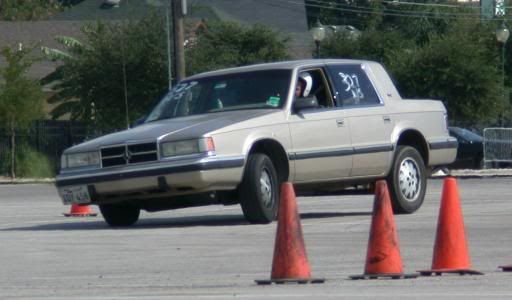It is a heavy, relatively powerful car. That's giving you some advantages and disadvantages, of course.
As others have said, only adjust air pressures right now. For a car like that, I would suggest starting around 40-42 psi in all the tires. In front, that will help them not roll over under cornering. In the rear, which is less heavily loaded, it will reduce grip a little. If you notice rub marks way up the sidewall in front, try stepping up to 44 or 46 psi.
In stock form, your biggest challenge will be learning to drive to the ability of the car. Braking too late and making harsh steering inputs will definitely bring out the worst in the car. Brake early, brake hard in a straight line, and ease up on the brakes as you turn in for each corner. This will slow the car and transfer weight forward, without overwhelming the front tires. Keeping some weight up front (by the reduced braking, also called "trail braking") will help the turn-in, and at the same time, the reduced rear load will help the car rotate.
The key is to not overdrive. Flogging the car will not make it faster, it will just make it plow more and scrub off speed in the corners. Make prompt but smooth turn ins, then transition from brakes to gas as the chassis gets settled. For the entire second half of the turn, adjust your path with the throttle, not the steering wheel. If the car understeers and goes wide, lift your foot off the gas until it tucks back in line. Steering harder will just make the front tires crab more, costing you speed. This is a hard lesson to remember in the heat of the moment, and I for one am still working on it.
After several events in completely stock form - and take instructors on as many runs as you can - you might want to consider getting an alignment. In order to help the front tires stay square on the ground during turns, you want negative camber up front. I don't know the details of the Max's front end configuration, but on my daily, there where some locating pins at the top of the strut that could be removed to allow a little extra negative camber adjustment. Up to about -2 degrees camber will not really affect tire wear (and will probably actually improve it, IMHO) as long as the toe is approximately zero. This will help the car rotate in corners as well. If you can't do this, then keep making moderate adjustments to tire pressures to get the balance as close as you can. You may need to run substantially higher or lower pressures in the rear to get the effect you want.
Another option is to add a heavier swaybar at one end or the other, but I would not make this change until you have at least a half dozen events and lots of instructor runs under your belt. Do some research and find out which is more effective for the Maxima: typically in FWD cars, you want to stiffen the rear swaybar (or anti-roll bar, technically), which reduces traction relative to the front. However, in some cars, it is more effective to stiffen the FRONT bar, because a flatter cornering stance yields better traction due to the front tires meeting the pavement more effectively. This is especially true on cars that are very limited in how much negative camber can be achieved.
Hope this helps, and welcome to the adventure! Always remember two things: 1) you can never have too much instruction, and 2) this is supposed to be fun.















 Let me tell you, it wasn't that slow, even stock, even looking like that. Even today a good driver can show up to an event in a car just like that one, or yours, and pax in the top 3rd easily (excepting any mechanical issues or really poor tires). That's one thing you have to drill yourself on: dont blame the car. You can always drive better, and a fast driver in a slow car will do really well at almost any local event.
Let me tell you, it wasn't that slow, even stock, even looking like that. Even today a good driver can show up to an event in a car just like that one, or yours, and pax in the top 3rd easily (excepting any mechanical issues or really poor tires). That's one thing you have to drill yourself on: dont blame the car. You can always drive better, and a fast driver in a slow car will do really well at almost any local event. 




















